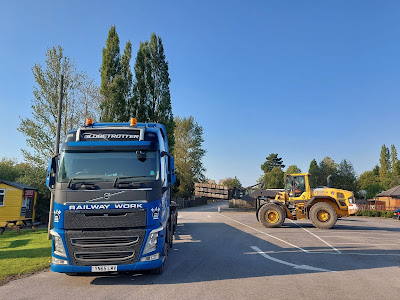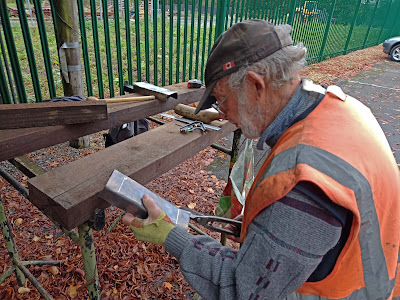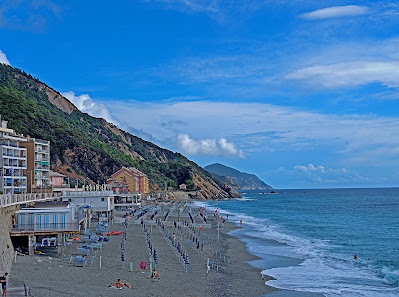Thursday at Broadway.
Another fine sunny day, so brick laying went apace.
We had a steamer on today (3850) and a DMU - the one that is now for sale. It certainly looked very tidy, the buyer will be a very lucky one to get this.
As the unit is leaving the GWSR, we thought we'd take a few pictures of it, and then there is also a video at the end of Thursday's report.
The day looked very busy for the station staff. Lots of people on the platform here, and you can glimpse a coach in front of the station, one of two we saw at Broadway on Thursday. Let's hope that trickles down to the bottom line, there are the slip repair works at Toddington to pay for, and there is talk of a platform extension at Toddington by contractors.
Neal dropped in at the beginning of the day, before heading off to work on the canopy steelwork in the 'greenhouse'.
Neal reports that a further session of rivetting has taken place. Good progress then, it's all falling into place.
At the time of writing a visit by the RRV is planned on Monday to resupply the build with sand and cement, and move some pallets into more convenient positions.
During Thursday another 75 or so plinth headers were laid. John is well down the back now. The next session should see us round the corner and across the end, leaving the front to do.
That said, there won't be any brick laying next week, as John is taking a week off.
We spent most of the day dealing with the sizeable pile of bricks and rubble under the steps. Occasionally an anonymous wheelbarrow full arrives with more broken bricks, and then progress goes backwards, such as on Thursday.
We have now filled a pallet with recovered blues and reds, so it's not just rubble that we are making. Amongst the debris from the former waiting room is this piece of original slate. This is likely to have been used in the gents, possibly as a divider.
The piece is an inch thick, and if cut would make a square piece of 12 inches all round.
Is this of interest to anyone? If so, drop us a line via the blogger contact form. (top right)
The sun goes down earlier these days, so the last service, with the DMU again, had a bit of a glint on it. By this time the crowds had gone, and there was just a handful of passengers returning to Broadway.
Below is the link to the new video of the unit's departure earlier in the day.
Saturday out with the gang.
Seven of us on Saturday, and back to Gotherington. But that was pleasant - we had a nice chat with the owner of the station, and the pulling out of the spikes from the sleepers is always a fascinating challenge.
First things first, another dip manifested itself not far from the kink last week at the Skew bridge. This was at Granna Lane bridge.
The more experienced of us are now handling two jacks at once. Tony eyed us in, as we pumped, others started to find spare ballast to feed the Robels that filled the voids.
This was the site of the kink, north of Gotherington station, which you can see in the distance.
Nick stood ready to get going with the Robels, as 2807 accelerated away into the curve.
The dip was simple to fix, so we walked up to the yard at Skew Bridge to help Dave load some bags of ballast. These are for use at our young engineers weekend, which is coming up.
Skew bridge is among our favourite spots for a lineside shot, as is the Dixton straight, with Three Arch bridge just behind. Here 3850 leans into the curve that leads into Gotherington station.
After fixing the dip and filling two bags of ballast by hand, there was a certain tiredness amongst the gang, so we decided that it was lunch time.
Bryan was kind enough to let us sit on his bench, which as you can see, was also in the dry.
It was a day of dodging the showers - easy at Gotherington - so the ground was wet when we started the replacement of three more sleepers there.
We usually hammer the plates sideways, once the spikes are out (the fun bit). But one wouldn't budge, which was odd. Maybe if we took the weight off it with a couple of pumps on the jack?
Still no good, it was as if the base plate was nailed to the sleeper.
And it was ! Once we wiped the dirt off, you could see that instead of removing the spikes, the gang back in 1997 just cut the tops off, and put a new spike in the third hole (and vice versa on the other side).
So there was nothing for it but to jack the track up some more, and pull out the sleeper, base plate and all.
The replacement sleeper was easily fitted, but fitting it with replacement base plates - of the type with regular chair screws - didn't go well, as we couldn't get the holes to line up.
This puzzled us. Which idiot drilled the holes an inch out?
Rubbing some rust off the castings revealed that while two base plates looked the same, they had different numbers that varied by one digit.
The mysteries of track repair. You learn every day.
Then 2807 drifted into the station.
We stood back and leaned against a convenient platform wall.
In other PWay news, we have been successful in obtaining some rail that was lifted from the army camp at Bicester.
Two enormous lorries came to Toddington, laden with concrete sleepers.
The bundles of sleepers were so large that it would take our little Telehandler all day to unload them, so we hired in a rather more muscular model, which you can see here.
The sleepers have been stacked on the edge of the old garden centre site. Based on the number of related rails, there were about 375 of them.
The rail is still to come - 30 lengths of 60ft 113lb FB rail, in good condition. This will eventually serve to swap out some of the lesser quality stuff that we laid in the early days.
At Winchcombe, STEVIE was spotted with bags of sand and cement, ready for somewhere to go.
Monday at Broadway.
We are running out of sand and cement - there is just one bag of cement left at the time of writing. Just as well that our chief brick layer John is away for a week. Six more bags of sand, and twentyfive bags of cement have been delivered - to Winchcombe. Then it was a question of finding a free non-running day to get STEVIE to deliver it to Broadway on a trolley.
After quite along wait on Monday, people being late due to the heavy rain, STEVIE arrived at Broadway to meet a pair of surprised passengers.
The first job was to unload the 25 bags of cement to the front of the storage container.
These then had to be humped inside the container, about half a ton's worth.
STEVIE then reversed back to the site, where the 6 bags of sand were unloaded to a spot under the bridge.
While STEVIE was at Broadway the opportunity was seized to reposition some pallets and bags around the site. The bags of ballast at the south end were taken to the north end, out of the way. This makes the south end look neater.
Several pallets of reds were then moved closer to the build, as we will be needing these soon, and don't want to have to trudge up and down the platform to keep John supplied.
Tuesday with the Usketeers (not Wednesday)
Due to the heavy rain, and similar outlook, we moved our Wednesday on the fence to Tuesday, the least bad day of the week. Three of us on Tuesday then, with Dave away for a week.
First thing to do was check out what Neal told us on Monday: the trusses have been moved inside the loco shed - 3850 having completed its overhaul - and are positioned ready for riveting.
Here they are, stood on a fascia board for support, with an A frame overhead to keep them upright.
Coffee drunk, and a week's news exchanged, we got on with our jobs.
John made lead caps for the big uprights. These will prevent one of the prinicpal causes of rot in the wood, water penetration from above. The other big cause is rotting at ground level, and we have prevented that by means of the godfather posts.
So the fence should last.
Paul was completing the rectification of the fence's line. As the concrete posts have had to avoid a buried powerline, and big tree roots, the line was less straight than we would have wanted.
This was corrected in two places with spacer blocks of wood, one of which you can see here. Now the line is pretty much perfect, but for a small detour around that pine tree.
Yours Truly was on creosoting the fence, for a second time. We really want this fence to last, and also look darker, as it used to. Just one coat makes the wood come out in a tan colour.
After correcting the line of the fence, Paul made a start with the final panel of the featherboard fence that we put up earlier. An 18 inch gap by the gate had not yet been closed.
Here is that gap now closed, and the featherboard fence finally completed.
The second coat of the creosote is also done, and we have also sourced a length of chain to lock the double gate.
All that now remains to do is to finish fitting the lead caps, and load up the Heras fencing panels and take them back into store at Winchcombe. Next week should see that done, and we have also booked ourselves a table in a nearby pub for a little celebration - at our expense, of course.
Block laying at Broadway will be next for the Usk team then.
Taking a car down a railway tunnel.
A final report from the Cinque Terre railway line. This ran between La Spezia and Sestri Levante, and due to the steep rocky cliffs that go right down to the sea, much of the line was built in tunnels at great expense. It opened in 1874, and was built as a single track line. It soon became apparent that a single track railway could not handle the volume of traffic, and from the 1930s to 1971 the line was completely rebuilt a short distance further inland, now with double track.
That left the old, single track line unused, with 51 tunnels in just 28 km.
We mentioned in an earlier blogpost that 6km of the old tunnels have been converted into an attractive coastal cyclepath. At the northern end of the rebuilt line, just south of Sestri Levante, the remaining tunnels are in use as a road, as there is no road along this steep coast. Not a lot seems to have been done to the old railway tunnels, just tarmac and some lights. They are slightly wider than your car...
There is a traffic light system for alternate streams. A notice explains that the traffic light turns green three times an hour, and you are required to keep to a minimum speed of 40 km/h, to keep things going. That's pretty fast if you are just 2ft from the tunnel wall, for several miles.
In the middle there is an open bit, and a second traffic light. As were were then head of the queue, we got Mrs. Blogger to record this second half:
The road-in-a-tunnel ends at Deiva Marina. Most of the rest to Framura (start of the cycle route) is disused, and in places affected by rock falls.
At Deiva Marina the line ran right along the beach, in an elevated position.
This picture was taken from where the tracks used to run, and the yellow building on the left is the former station building, now a restaurent. (very fitting)
The back of the building gives you an idea how high it was above the beach.
To the left is the remains of a little underpass that gave direct access to the beach.
Several further arches were replaced in the 1970s by a concrete underground car park and shopping centre. It was a nice idea at the time, very modern, but today it looks tired, and concrete and seawater spray do not go well together.
Through the little town there ran a 'torrente', a largeish stream with little action in the summer, but one that can become quite active when heavy squalls fall on the nearby mountains.
The railway crossed it by a series of short arches, a stub of which you can see on the left.
What remains of the little viaduct with short arches has been attacked in the interests of modernity, but you can see that it did have some character from the little underpass that remains on the right. Better than the concrete car park and shopping arcade that look so tired near the old station.
Behind the camera, so turning round to look inland at the same spot, you can see the new line from 1932, a few hundred yards inland.
Beyond are the hills that can, if heavy rain, cause the 'torrente' to swell considerably.
This is what the original station used to look like:
(Use Google translate if any pages are in Italian)
Finally, a last shot onwards towards the south, Framura and the Cinque Terre. Just visible to the right of the orange group of houses, centre left, is a lengthman's house. This marks the entrance to the next tunnel, a short one, which leads to a caravan park. After that the old tunnels are blocked until Framura.
Next week, we hope, an update from the L&B track buying vehicle, Exmoor Associates. There's an update meeting on Saturday, which we will attend. What will they have in store for us?






































I'm surprised no comment on the van parked on the platform at Broadway.
ReplyDeleteMore seriously, chain falls off gates and vanishes, telescopic driveway barriers don't. Can't recommend them enough to protect gates of large open spaces.
The photos of the line through Deiva Marina remind me of Dawlish, where the station is right on the sea front, although with a building on the seaward side, thus actually in the sea at high tide. Dawlish also has a torrente of its own, in the shape of a small river called the Dawlish Water, which can become quite fierce after rain.
ReplyDeleteIn the 1930s the Great Western Railway proposed building a new railway inland, and work did actually start - but then WW2 came along and there were other priorities. After the war, when the railways were nationalised, there was no need for a separate GWR route to avoid the coastal section, because the Dartmoor route via Okehampton, previously jealously guarded by the Southern Railway, became available to all trains if needed. The Dartmoor line eventually closed as a through route, leaving two branches at each end, and people have been talking about reopening it ever since.
Just recently the sea wall has been substantially rebuilt through Dawlish, so the station no longer sits in the sea. This video gives a good overview:
https://youtu.be/mkaSHf-Y_HA?si=Lty1jFN-UJoKVGM3